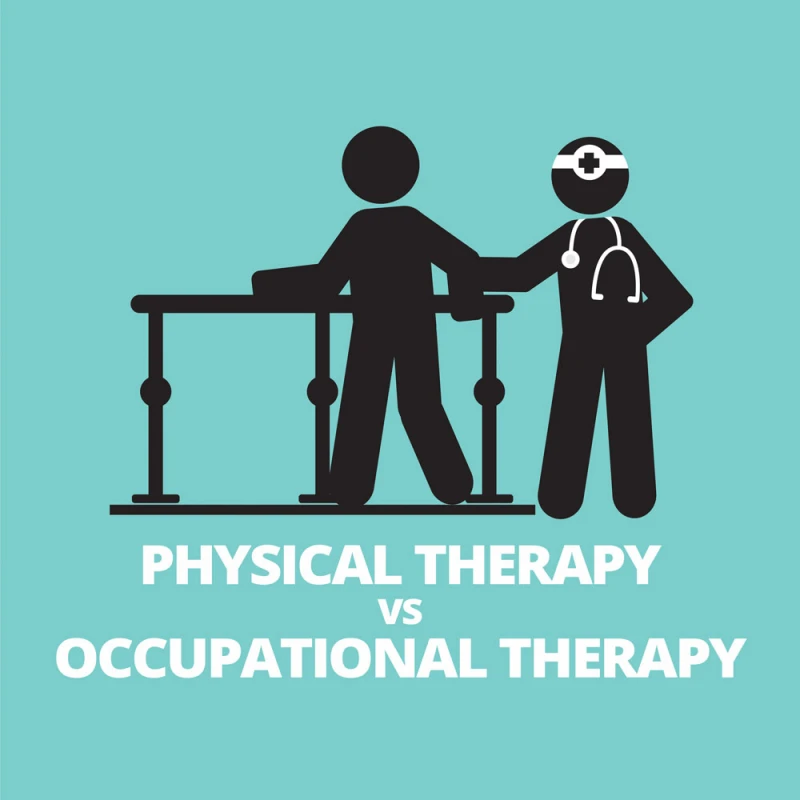
PT vs. OT: What's the Difference?
 You've probably heard the terms "physical therapy" and "occupational therapy" (or "PT" and "OT"), and may think they're two terms for the same thing. While PT and OT often work together in the rehabilitative process, they are different disciplines with separate overall goals.
You've probably heard the terms "physical therapy" and "occupational therapy" (or "PT" and "OT"), and may think they're two terms for the same thing. While PT and OT often work together in the rehabilitative process, they are different disciplines with separate overall goals.
So, what are the differences between physical therapy and occupational therapy?
What Is Physical Therapy?
Physical therapy (PT) is the actual physical rehabilitation of patients recovering from an illness or injury. The most basic goal of physical therapy is to restore mobility and as close to normal function as possible. In some cases, physical therapy aims to avoid surgery or other more invasive treatment measures. PTs also educate the patient in ways to prevent and avoid further injury in the future, including at-home exercises.
An example of physical therapy is a person with a shoulder injury who is taken through a series of stretching and strengthening exercises, with the goal of returning the shoulder to normal function. This patient may be given at-home exercises, a special brace, or other minimally invasive treatment to help aid in recovery.
The daily duties of a PT center around the assessment of the strength, functional capacity, and motor development of patients, developing individualized care and treatment plans to meet these patients where they're at and work toward their individual goals. The first contact a PT is likely to have with a patient will include a full assessment, which forms the jumping-off point of treatment. This assessment is repeated multiple times during the course of treatment, allowing the PT to assess the patient's progress and adapt the treatment plan as necessary.
A PT also leads patients through a series of exercises, as outlined in the treatment plan. These exercises can include stretching, strengthening, or balance exercises, depending on the patient's needs.
What Is Occupational Therapy?
Occupational therapy (OT) is mainly focused on helping the patient engage in the meaningful activities of daily life, such as self-feeding, dressing, working, etc., as seamlessly as possible. Though there is also a physical mobility and health component to occupational therapy, OTs work toward helping the patient adapt long-term, and an OT's help can include helpful modifications to the environment or other therapeutic adaptations. Occupational therapists may not engage in the actual manipulation and exercise portion of helping a patient deal with an injury, but rather focus on teaching the patient adaptive life skills.
An occupational therapist may, for example, work with a stroke victim, teaching him how to feed and dress himself to accommodate any weakness resulting from the stroke, and helping him make critical adaptations to his environment to make it safe and geared toward independent functioning.
Like PTs, OTs also spend a portion of their days working on the physical health and functional capacity of their patients. OTs must also understand the mental health component of illness and recovery, as they assist patients with adapting their daily lives to accommodate their conditions. Many OTs perform off-site visits to patients' homes and workplaces, providing advice on changes to implement to allow the patient to perform as fully as possible within her individual capability.
Do PT and OT Work Together?
In some cases, especially in the event of a permanent injury or condition, a patient will receive both physical therapy and occupational therapy. The two disciplines do often work very closely together even though they have different methods and overall goals. Ultimately, both PTs and OTs want their patients to be as healthy, happy, and functional in the world as possible.
Experienced Physical Therapy in Central Maryland
At MMI, we offer physical therapy performed by highly trained, experienced physical therapists, for adults, teens, and children suffering from a variety of conditions. Contact our offices today to begin your journey back to better health and function.